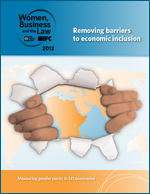Tuesday 27th September 2011
 While 36 economies reduced legal differences between men and women, 103 out of 141 economies studied still impose legal differences on the basis of gender in at least one of the report’s key indicators, according to the report entitled: ‘Women, Business and the Law 2012: Removing Barriers to Economic Inclusion”
While 36 economies reduced legal differences between men and women, 103 out of 141 economies studied still impose legal differences on the basis of gender in at least one of the report’s key indicators, according to the report entitled: ‘Women, Business and the Law 2012: Removing Barriers to Economic Inclusion”
The report also identifies 41 law and regulatory reforms enacted between June 2009 and March 2011 that could enhance women’s economic opportunities. Out of 35 economies covered in Sub-Saharan Africa, only ten: Angola, Burkina Faso, Ethiopia, Kenya, Liberia, Mauritius, Namibia, South Africa, Zambia and Zimbabwe have no legal gender differentiation regarding the usage of property and basic legal transactions such as signing a contract or getting a passport.
However, in Zambia customary law or personal law are considered valid sources of law even if they violate constitutional provisions on nondiscrimination or equality. Therefore, customary law may take away from legal gender parity.
Meanwhile, the region is slowly but surely moving towards more gender parity. Kenya was a top reformer, with the promulgation of its new Constitution which included a number of positive measures for women. And in Botswana the newly introduced small claims court is often used by women to collect child maintenance.
There are also new credit bureaus in Ghana and Uganda and Mauritania that cut the minimum loan amount for inclusion in the credit bureau by half.
In Sub-Saharan Africa only Lesotho does not provide paid maternity leave. But only 15 economies out of 35 provide any type of paternity leave and none provides for parental leave – where both the mother and the father share the child raising responsibilities.
Seven economies in Sub-Saharan Africa made changes over the past one year and half that affected the indicators in Women, Business and the Law. Those economies are: Botswana, Ghana, Kenya, Mauritania, Rwanda, South Africa and Uganda. Kenya was the country with the highest number of reforms.
Globally, women represent 49.6 percent of the population but only 40.8 percent of the workforce in the formal sector. Legal differences between men and women may explain this gap. The report shows that economies with greater legal differentiation between men and women have, on average, lower female participation in the formal labor force.
“Competitiveness and productivity have much to do with the efficient allocation of resources, including human resources,” said Augusto Lopez-Claros, Director, Global Indicators and Analysis, World Bank Group. “The economy suffers when half of the world’s population is prevented from fully participating. It is certainly no surprise that the world’s most competitive economies are those where the opportunity gap between women and men is the narrowest.”
The report measures such things as a woman’s ability to sign a contract, travel abroad, manage property, and interact with public authorities and the private sector. In all economies, married women face more legal differentiations than unmarried women. In 23 economies, married women cannot legally choose where to live, and in 29 they cannot be legally recognized as head of household.
Every region includes economies with unequal rules for men and women, although the extent of the inequality varies widely. On average, high-income economies have fewer differences than middle- and low-income economies.
The Middle East and North Africa have the most legal differences between men and women, followed by South Asia and Africa. In Africa, a notable exception is Kenya, which leads globally with the most gender-parity reforms during the past two years. Regionally, the most improvements in gender parity occurred in Latin America and the Caribbean, Europe and Central Asia.